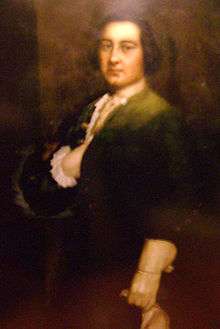Paul Carrington (judge)
Paul Carrington (March 16, 1733–June 23, 1818) was a Virginia lawyer, judge and politician. He served in the House of Burgesses before being elected a Justice of the Virginia Court of Appeals (now the Supreme Court of Virginia). He was a delegate to the Virginia Ratifying Convention in 1788, and cast his vote for ratification of the United States Constitution.
Paul Carrington | |
|---|---|
 | |
| Justice of the Virginia Supreme Court | |
| In office December 24, 1788 – July 30, 1807 | |
| Personal details | |
| Born | March 16, 1733 Charlotte County, Colony of Virginia |
| Died | June 23, 1818 (aged 85) Halifax County, Virginia |
| Spouse(s) | Margaret Read, Priscilla Sims |
| Occupation | Lawyer, judge, politician |
Biography
Carrington was born at "Boston Hill" in Cumberland County, Colony of Virginia on March 16, 1733, the son of Col. George Carrington (1711–1785) and Johanna Mayo (1712–1785). His paternal grandparents were Dr. Paul Carrington and Henningham Codrington, who had migrated from England to the Island of Barbados; his father immigrated to the Colony of Virginia in 1723. Carrington's maternal grandparents were Major William Mayo and Frances Gould.[1]
At about age 17, he began to study law under Colonel Clement Read in Lunenburg County and received his license to practice in May 1755, signed by Peyton Randolph, John Randolph and George Wythe. On October 1 of that year he was married to Margaret Read, Col. Read's second daughter, and they resided at Mulberry Hill. Their children included George Carrington (1756–1809), Mary Scott Carrington Venable (1758–1837), Ann Carrington Cabell (1760–1838), Clement Carrington (1762–1847) and Paul Carrington (1764–1816).[1]
Carrington was for many years a vestryman and churchwarden of Cornwall Parish. He was appointed king's attorney of Bedford County in 1756, major of the Lunenburg County militia in 1761, and colonel of the Charlotte County militia in 1764. After practicing law in the county courts, Carrington was elected to the House of Burgesses from Charlotte County, from its first formation out of Lunenburg in 1765 until 1775. His wife died May 1, 1766, and he said of her, "she was the best of wives and a woman of innumerable virtues." He was appointed king's attorney of Mecklenburg County in 1767, of Botetourt County in 1770, and of Lunenburg County in 1770. Carrington was additionally made county lieutenant and presiding justice of Charlotte in 1772 and clerk of Halifax County that year. He was chairman of the Charlotte County Committee from 1774–1776, which endorsed the resolutions of the Continental Congress,[2] and in 1775 became a member of the first Board of Trustees in the founding of Hampden-Sydney College.[3]
.jpg)
He was elected a Judge of the first Virginia General Court under the newly adopted Virginia state constitution on January 23, 1778; as such, he thereby became the second Justice appointed to the new Court of Appeals, which was then composed of the judges from the General, the Admiralty and the Chancery Courts. In 1780 he became the Chief Justice of the Virginia General Court. In 1789, he was elected by the Virginia General Assembly to be a Justice of the reorganized Virginia Supreme Court of Appeals.[2]
In 1788, Carrington was a delegate to the Virginia Ratifying Convention, by which Virginia narrowly ratified the United States Constitution, by a vote of 89 – 79. Although he voted in favor of ratification, he also played a vigorous role in the development of the Virginia Declaration of Rights, which assisted as a model for the U.S. Bill of Rights.[4]
On March 6, 1792 Carrington married his second wife, Priscilla Sims, aged 16. Their children were: Henry Carrington (1793–1867), Lettice Priscilla Carrington Coles (1798–1875) and Robert Carrington (1802–1845). She died in September 1803 and he recorded that her loss was irreparable to him and to her family.[5]
At age 75, concerned as to his ability to fulfill his judicial duties, Carrington resigned from the bench in 1807. On August 1 of that year he wrote, "I have served the public a great many years, and I know with faithful integrity, I had arrived to a time of life that every man ought, in my opinion, to retire, and not remain and die at his post as some of my brethren have." Despite his fears, Judge Carrington lived in retirement another 11 years until he died at the age of 85.[5]
Judge Carrington is buried between his wives on the grounds at Mulberry Hill near Randolph, Virginia; his home was listed on the National Register of Historic Places in 1973. His papers, with the papers of his sons Clement and Robert Carrington, are held by the Library of Virginia. They encompass a wide variety of documents, including powers of attorney, judicial records, receipts, tax records, and deeds for the purchase of land and enslaved persons.[6]
References
- Brown, Alexander. The Cabells and Their Kin. Garrett and Massie, 1939, p. 223.
- Brown, Alexander. The Cabells and Their Kin. Garrett and Massie, 1939, p. 224.
- Brinkley, John Luster. On This Hill: A narrative history of Hampden–Sydney College, 1774–1994. Hampden–Sydney: 1994, p.10.
- Brown, Alexander. The Cabells and Their Kin. Garrett and Massie, 1939, p. 225.
- Brown, Alexander. The Cabells and Their Kin. Garrett and Massie, 1939, p. 226.
- "A Guide to the Carrington Family Papers, 1756-1843 Carrington Family Papers, 1756-1843 20459". ead.lib.virginia.edu. Retrieved 2019-06-13.